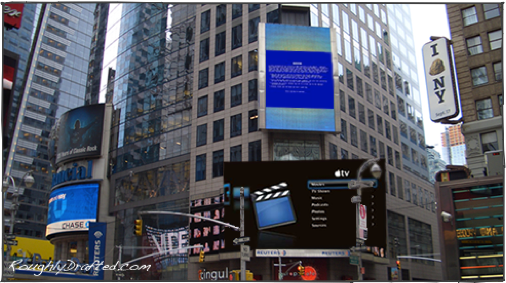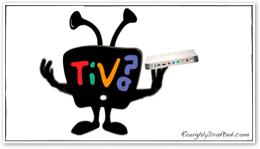


Last winter, a series of articles described how Apple would change TV by providing a new medium for different types of content: on demand commercial content, personal content, alternative content, interactive content, and original content.
Looked at from a different perspective, the new Apple TV--along with its integration with iTunes and the iTunes Store--will also change TV by offering alternatives to nearly every link of the television chain:
Production: The TV and movies produced today are largely determined by a few huge media corporations that control the vast majority of everything produced worldwide: GE, Time Warner, Walt Disney Company, Viacom, and News Corp.
They present news and style entertainment in every nearly channel available to consumers: books, magazines, television, radio, and theaters.
Distribution: Studios also control the distribution of content to theaters and through cable and broadcast affiliates. Along with AT&T/TCI, Cablevision, Charter, Comcast, Sony, and Universal, the big producers also own the vast majority of theaters, cable channels, broadcasting networks, and advertising channels.
Delivery: While anyone can make a film or author a DVD, being able to get played in theaters, promoted in advertising, or find a buyer in Walmart or Blockbuster--which together own the majority of outlets for DVDs sales and rentals--is another matter. Getting delivered means playing by the system’s entrenched rules.
There has long been little room for creating new ways to distribute new kinds of content. Existing channels only want to deliver content in high demand, and that demand is shaped by huge studios and big budget advertising. But without competition, markets stagnate.
Billionaire Games.
The content chain offers little room for real competition to shake things up, and purposely so. Nobody wants to upset a system that delivers regular profits.
Like the music industry, film and TV principally enrich only big studios and a minority of megastars, providing little variety in content and only risking few and cautious steps outside of proven business models.
Even the big studios have had a difficult time in introducing new channels. When Fox launched the fourth US TV broadcast network, it was criticized by those who assumed there was really only room for three networks. Fox survived, but attempts to copy its success by Warner's WB and Paramount's UPN didn't; they ended up merged into the struggling CW.
The Current State of Media.
If the major media companies find it hard to launch and maintain new networks, imagine the plight of independent channels. NewsWorld International, a cable news channel created by the Canadian Broadcasting Corporation, was bought and passed around throughout the 90s, ending up as part of what is now Vivendi.
It was then bought by Al Gore and Joel Hyatt with the intent of setting up a democratized, user driven cable news channel. The result, Current TV, still struggles to find airplay and is only available to most cable and satellite subscribers as channel two hundred and something.
Few people have even heard of Current TV, even within the youth demographic the channel attempts to target, and even within the city where Current is based.
The only people that watch it seem to be the indie filmmakers who create its content, and even they might not be paying much attention. It's like YouTube without the Internet, but with technical production values instead. Meanwhile, in the real world, TV remains chained to the old ways of doing things.
Blindsided by the Web.
When the commercial Internet began to emerge, the studios didn't know what to do with it. They tried to remake the web into a new way to watch their TV and movies, but technical limitations initially prevented the web from being able to deliver anything comparable to what they already could ship on cable TV or via DVDs.
To the studios, the Internet has largely just been a seedy back alley that traffics bits of their content without paying for it. Beyond using their cable, satellite, and telephone channels to deliver Internet service, big media corporations have long viewed the web as being only a new way to advertise.
The companies making the most money on the web--and in particular, Google--are making their vast revenues from selling ad placement. Google offers free services to users that make the web useful, in exchange for presenting advertisements.
The big media companies haven't be able to do the same. Efforts to buy up websites and turn the web into a new monetized medium with advertising didn't work out as expected; Time Warner's disastrous attempt to merge with the inflated AOL is just one example.
That’s because users aren't drawn to the web to be presented with the same information and the same force-fed advertising they can already get on TV. The web is popular because it's not TV.
Ten years ago, Microsoft decided to expand its market control outside of computing, and announced plans to turn the Windows PC into an interactive Microsoft TV. Windows 95 would allow users to tune into Active Channels and have content pushed directly to them. Push became one of the first buzzwords to help to inflate the tech bubble.
Microsoft's innovative Channel Definition Format was of course only a copy of Netscape's Resource Description Framework, a system for distributing metadata between websites to abstractly describe the available content.
Netscape had inherited RDF from Apple; research on the Metadata Content Framework began with Ramanathan Guha in Apple's Advanced Technology Group. Netscape’s RDF was Guha’s implementation in XML.
After failing to find any immediate profits from Active Channel and CDF, Microsoft abandoned the idea. Parallel efforts to buy Web TV and migrate the system to Windows also fell apart, leaving Microsoft with the remains of two piles of acquired technology that the company's executives had no idea what to do with. Microsoft set to work on copying the Tivo as a Windows application instead: Media Center.
Meanwhile, Netscape continued to work on its RDF, developing the RDF Site Summary as a standardized way for websites to advertise new content in a subscription feed. RSS was later re-imagined as Really Simple Syndication.
Yanking the Chain.
After Apple got itself back on track, the company began pioneering the use of RSS throughout its products. In addition to RSS support in Safari, Apple also uses RSS in iPhoto to allow users to "photocast," or publish automatic announcements of new photos for their subscribed audience.
Apple also uses RSS to advertise the latest new music and has built podcast support in iTunes to manage a library of standard RSS feeds that allow anyone to hook up with the content others publish.
Instead of trying to push existing commercial content at users as Microsoft attempted to do, Apple is offering users ways to push their own content.
RSS is really simple, but its simplicity is part of its power. It quietly and automatically works in the background to update new content and facilitate delivery; it automates the web. Rather than pushing commercials at users, it gives users ways to select and filter just the information they want to obtain.
The Windows PC didn't ever successfully converge with TV. Microsoft put tuners in PCs and bundled in software to record existing content for later, but what consumers really need is the power to both publish their own expressions and tune into unique channels of information outside of the existing content chain.
Apple TV doesn't invent new content, and doesn't offer a new way to do things consumers can already do: it's not a DVR, and it isn't a DVD player.
What it does that is new and powerful is offer users a way to obtain content that isn't being created and distributed by the same system that, like a Pla-Doh extruder, can only push out the same shape and color that it always has.
Power of Podcasting.
Instead, Apple TV plugs into iTunes to let users enjoy their own content and also download alternative content from aspiring podcasters, using the same metadata technology that was originally born within Apple and then ran off to serve a tour of duty in the browsers wars before returning home to raise a software family.
In addition to powering amateurs, iTunes' automated RSS delivery system also provides Apple with a powerful position in the content chain. Apple already distributes nearly all of the world's paid music and movie downloads; that business will help establish Apple TV as a common way to deliver existing content. Once a critical mass is established, Apple will have the same TV audience it has with the iPod as a music player.
Critics who crow about the Apple TV's supposed technical deficiencies and missing features--the lack of a TV tuner is a classic example--are just failing to grasp what it does.
These are the same people who thought putting an FM radio in the iPod would help complete it. They were wrong then, and they're wrong now. Engineering isn't about adding features, it's about making things work. Good engineers know what to leave out.
The Apple TV Audience.
With its Apple TV audience, the company will be able deliver independent filmmakers and producers an alternative way to be seen. Theaters, broadcasters, and DVD rental and retail outlets won't be the only game in town for distributing content into the mainstream.
That's already happening; iTunes already provides content from independents, and also provides access to short films and other material that has always lacked a workable distribution model. Renters and retailers can only stock a finite number of titles--Blockbuster is a fitting name--but Apple can warehouse and market trillions of digital bits whether they happen sell in large quantity or not.
Tools For Users.
Apple didn't invent the Internet, or the idea of podcasting, but it was quick to identify the value in offering tools to serve users, not just suppliers. For example, Microsoft didn't offer anything comparable to iLife until Apple's software made Windows look conspicuously lacking.
With the Zune, Microsoft similarly didn't bother to add even rudimentary RSS support for downloading and managing podcasts. Zune users don't seem to understand what podcasting even is, and commonly insist that podcasts are simply audio files, so no support should even be necessary. But podcasting is about automating the link between producers and consumers: it's intelligence for the web.
It's an automated Google, which answers the same query at regular intervals and manages the search results intelligently. People can find articles without RSS and can download media files without a podcast feed in the same way they can find stuff without Google. RSS simply makes things work better; it's a value add on the web.
In the same way that Apple thought to push a graphical interface at a time when Microsoft was making plenty of money selling text, Apple is again pushing the state of the art to deliver applications of technologies that Microsoft fails to grasp any value in targeting.
Microsoft: Where Do We Want To Go?
The reason Microsoft's Media Center PC went over like a Zune Balloon was because the company's executives don't understand how to solve users problems; they can only offer to make things worse by squirting in features that make little sense and saturating their products with short term profiteering: adware and anti-consumer sheepware: all you can eat mainstream media junk food, as long as you pay every month.
Microsoft took the idea behind RSS and played it as a way to make the PC like yesterday's TV. Apple is using RSS to make computing the TV of tomorrow. The next article will look at lessons from history and the technical details that play into why Apple TV is really something new.
Like reading RoughlyDrafted? Share articles with your friends, link from your blog, and subscribe to my podcast!
Did I miss any details?
Next Articles:
This Series

Haloscan Q107
RSS: How Apple Will Change TV in 2007
Wednesday, April 4, 2007

Ad








 Bookmark on Del.icio.us
Bookmark on Del.icio.us Discuss on Reddit
Discuss on Reddit Critically review on NewsTrust
Critically review on NewsTrust Forward to Friends
Forward to Friends
 Get RSS Feed
Get RSS Feed Download RSS Widget
Download RSS Widget





